Dave Theurer’s nightmare has come real (in game form)
Type: Singleplayer, Multiplayer
Genre: Strategy
Developer: SoftWarWare
Publisher: Slitherine Ltd.
Release date: 17 Nov, 2020


Games about global thermonuclear war are nothing new, in fact they’ve been around since at least 1980, which was when Dave Theurer released his famous arcade hit Missile Command (which, according to legend, made him have nightmares about global thermonuclear war for years afterwards). Other games have since come along that tried to inject some strategy into these world ending games, like Defcon by Introversion Software (which also likely got at least some inspiration from the 1983 movie WarGames). ICBM continues where Defcon left off, and adds a deeper level of strategy to wiping out humanity.
ICBM sees you command a part of the world, be it Europe, Oceania, South America or any of the other available ones during a time where war is inevitable. Every region is preparing for war, and your goal is to come out on top during this war, with hopefully enough people still alive to celebrate your victory. There’s no real story here, no reason for war happening, it just will happen, and hopefully you’re ready for it.
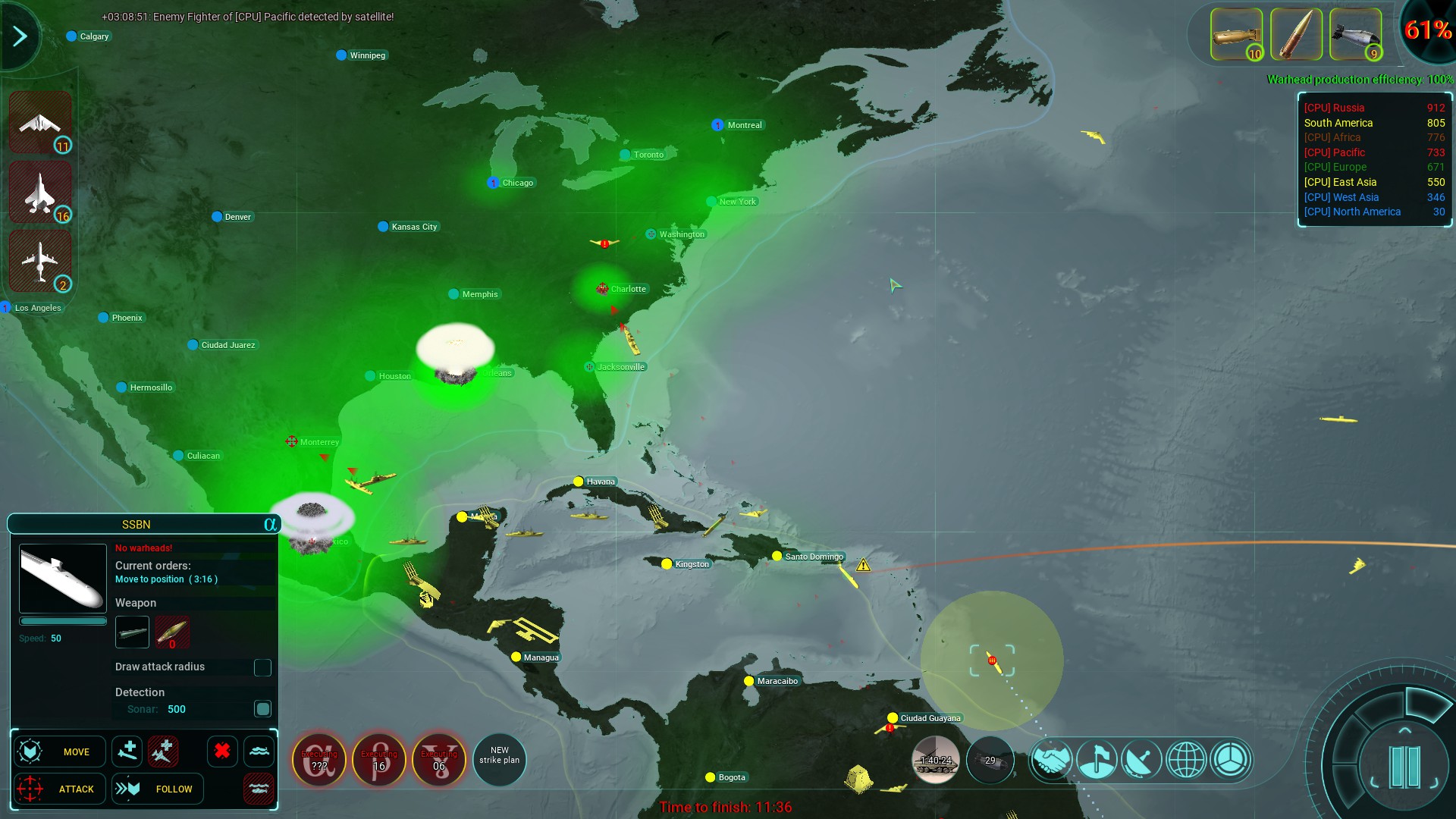
Presentation
There’s something eerily cold about ICBM’s presentation. Cities are just dots on a map that, if you click on them, will tell you how many live in the city, any units or structures are just simple single colour models, be it your ships, airplanes, SAM-sites or airports. When an atomic bomb goes off all you’ll hear is a distant thud and the UI looks clean, and almost clinical. Missiles that might end up killing millions if they hit are just red triangles flying through the sky, leaving an orange trail behind them.
Accompanying this is an electronic soundtrack that does go up a bit in tempo as the world is starting to glow green with radioactivity, but which further adds to the coldness of the game. A computer voice will occasionally tell you in a very matter of fact way that a city has been hit, or a ship has been sunk, while showing no emotion while doing so.
All of this is very likely to be intentional. You’re meant to be willing to wipe out entire cities full of people with a click of a button, and not feel any emotional connection to what’s actually supposed to be happening. You’re not dealing with people, you’re dealing with numbers, statistics, and the game does a good job at conveying this through its presentation
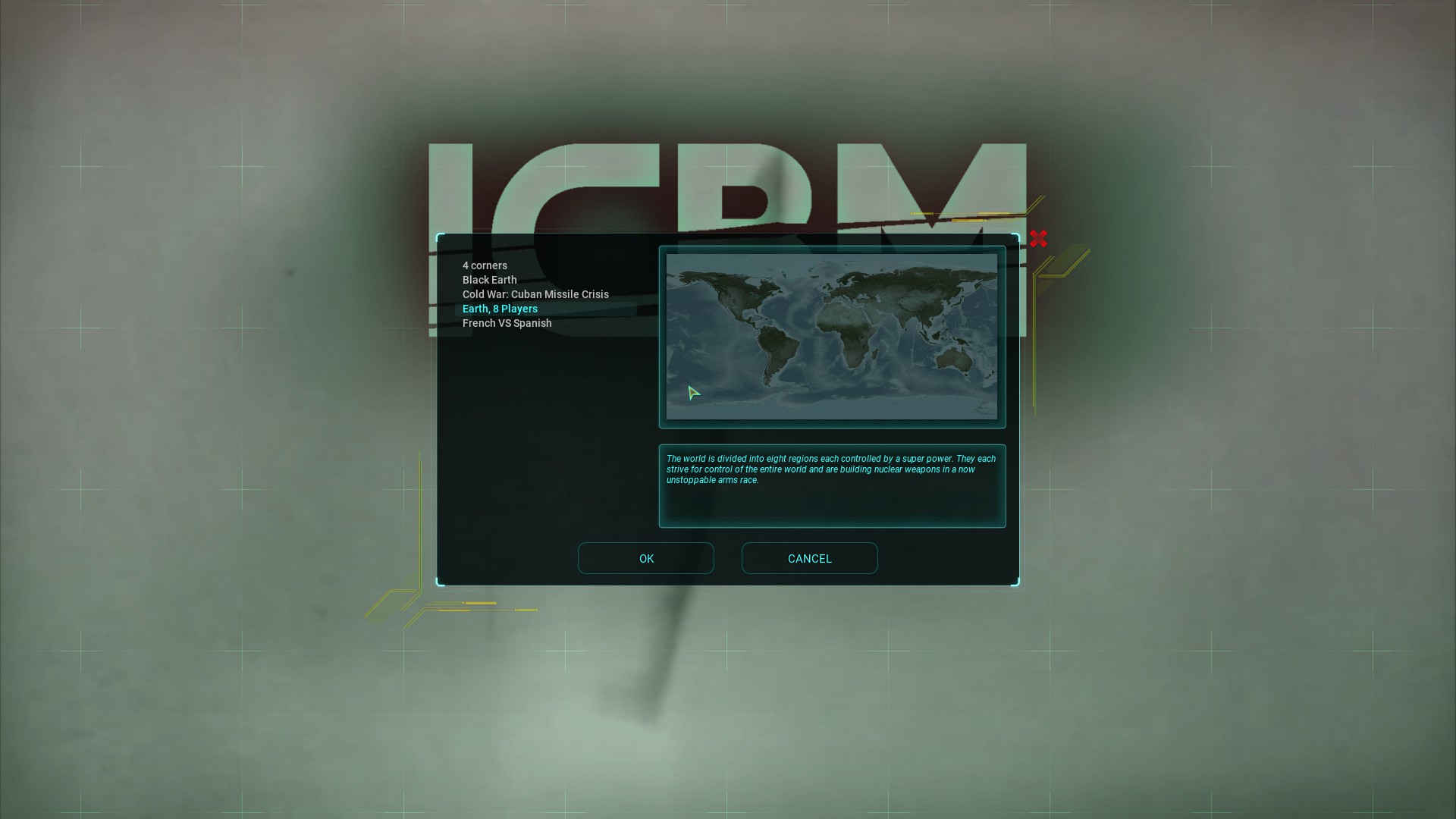
Gameplay
In ICBM you’re leading a region through global thermonuclear war. Before the game ends the world will have a sickly green glow, and your job is to make sure that as much of that glow is coming from places that’s not where you are. This is done through researching, building and then deploying new weapons and weapon delivery systems, as well as defensive structures and spy satellites. It’s not an overly complex game, and you’re not meant to micromanage a lot of different units, instead you’re doing things through broad strokes, you’re telling your pilots to bomb Europe, or your nuclear launch sites to send intercontinental ballistic missiles (ICBMs) to Africa, and what kind of targets they should prioritize, like cities, radar sites and so on.
But before the missiles start to fly you need to prepare. Research and production is handled in a very simple and straight forward, though still quite effective way. There’s a slider used to allocate resources to either production or research with and the change is linear. Allocate 100% of your resources to research and you’ll research things twice as fast as if you allocate 50% of them.
For research have a set of different topics that you can focus on, some of which give you access to new toys, and some improve what you already have, and then you just research new topics one at a time. Some are dependent on others, so you can’t research the ability to make missile launching vehicles until you have the ability to produce fixed launch sites, and you can’t research mobile SAM sites until you have fixed ones. The limitations usually make sense, and all in all there’s quite a lot of topics you can research.
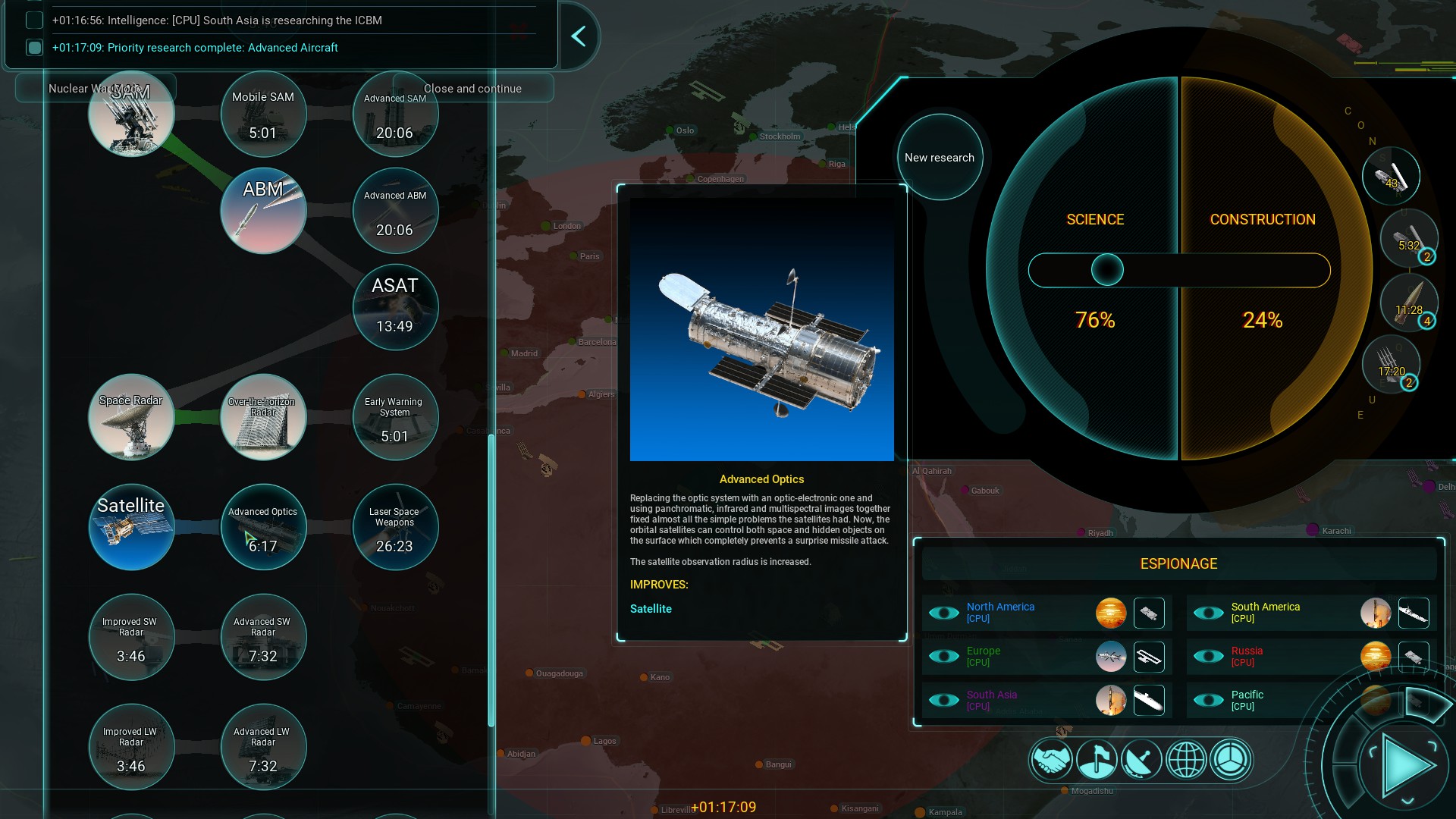
Production works similarly to research in that you chose what to produce and one thing gets produced at a time. Smaller things, like fighter planes, are produced really fast, while big things, like submarines capable of launching nuclear missiles or carrier ships, take far longer. Anything you build will also come fully loaded, so an airfield will have the maximum number of planes when you build it (planes can be lost in combat though, and you need to build any replacements), and a launch site will come with a missile. Missiles and atomic bombs also need to be built, after a launch site has sent a missile it will only be able to shoot another after you’ve built a new missile. These missiles can be stockpiles though, so you don’t just need to build new ones as soon as you’ve attacked.
You can’t just start flinging missiles from the word go. Early in the game any heavier weapons will take a long time to build, but as the game progresses your production efficiency for heavier weapons go up. At the start of the game it’s 10%, while things that are not weapons of mass destruction don’t get this penalty. This production inefficiency also extends to anything carrying these weapons, so you can’t cheat the system by building missile silos in the early game.
There’s a rudimentary diplomacy system in place. Through it you can join an alliance, share research with your allies as well as some other information. It’s simplistic, but functions, though the AI does not seem to be very good at actually using it, and at the start of the game the first AI opponent you try to invite will join your alliance, and then they may or may not accept other people into your alliance.
Before the missiles start to fly you can still do small scale attacks on your opponents. Bombers carrying conventional bombs, as well as warships, are capable of attacking enemy structures and ships, and fighter airplanes and SAM sites will try to shoot down enemy planes. It’s not a bad idea to weaken the enemy as much as you can before the war starts properly, as anything you destroy now is something that they either have to spend production time replacing, or it won’t be there later.
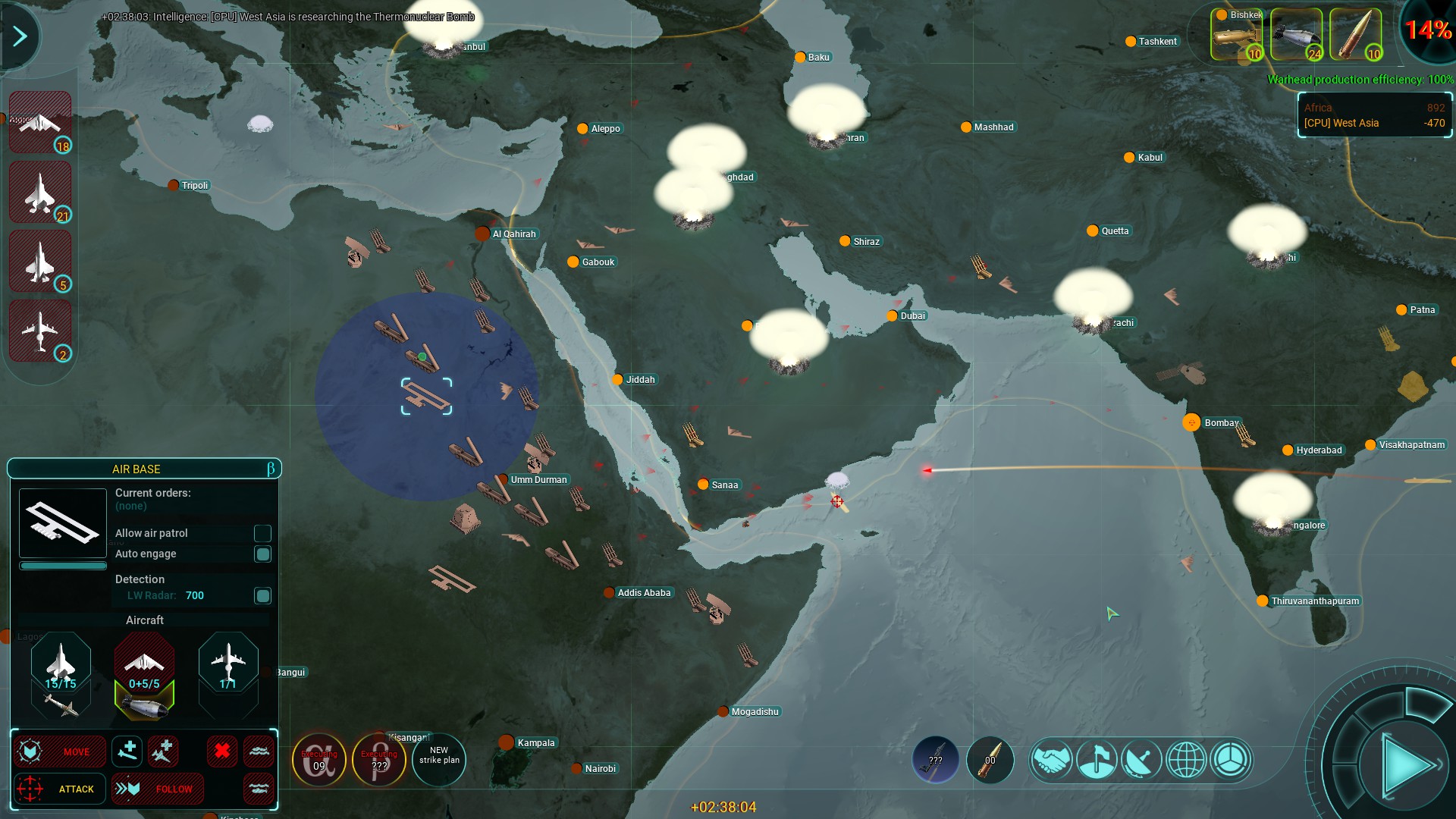
Once the missiles start flying there’s no turning back. Global thermonuclear war will have started, and hopefully you’re prepared for it. This quickly devolves into a mess where things get destroyed far faster than you can replace them, and cities get bombed repeatedly. It’s hard to keep up with everything going on, and that’s why you can set up attack plans beforehand. You always have the option to manually set targets, but with several airports, maybe a dozen launch sites and warships patrolling the coasts it’s not really realistic to do it all by hand, so that’s why you need to set up attack plans beforehand. Here you can chose what targets what, and what’s a priority target. Want your bombers to drop nukes on major population centers of your neighbour, while your launch vehicles target any SAM sites and your missile silos try to blow up the stuff that your supposed partner controls on the other side of the world? You can and probably should do that, and once it’s time for war you just need to hit a single button for each unit type in order to set that plan in motion. Exactly what your plan will be will of course depend on what you’ve chosen to focus on. If you’ve chosen to make a huge navy then that will require a different attack plan than if you’ve covered your home region with missile silos.
When the war starts properly a timer will start ticking down. Once it reaches 0 the game will end, and hopefully your territory will be more livable than that of your opponents. Although chances are that both your region and theirs will be a nuclear wasteland, and the “winner” will just be the one with a slightly less ruined nuclear wasteland.
There are some interesting touches in ICBM that you usually don’t see in strategy games. The game takes place on a globe, and you can switch to viewing the world map as such, but most of the time you’ll probably just view the world as a flat projection. The game still does all the calculations as if the world was round. This is especially noticeable when you place something with a long range somewhere, as the “circle” around it that shows range will be slightly squashed and distorted. Ships also seem to move faster the further from the equator they are.
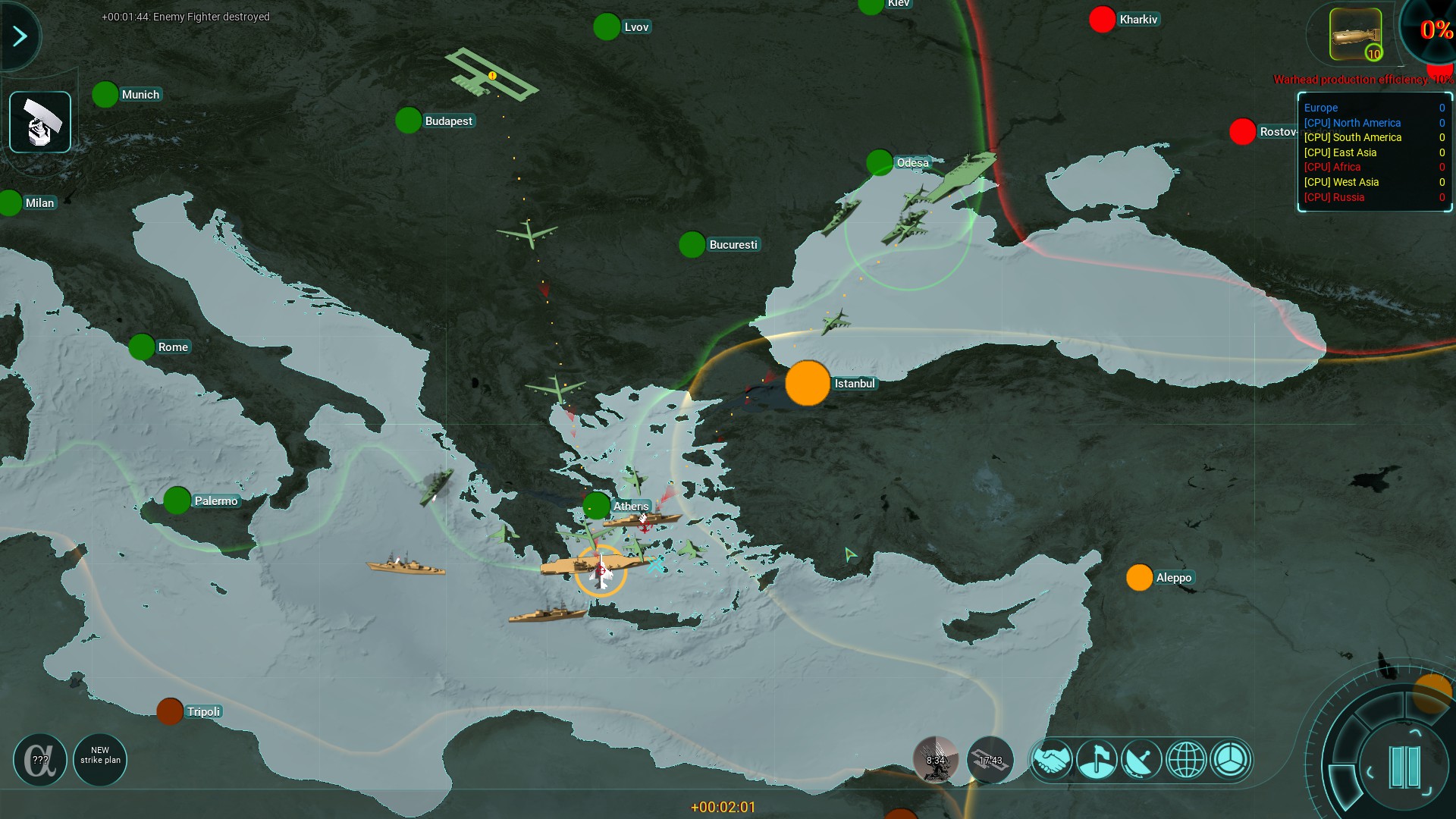
ICBM is clearly built for multiplayer. Singleplayer is fine, but is likely to get a bit repetitive after a few hours, as the AI is less dynamic than a real player will be. That’s not to say that the AI is terrible, it seems to be quite capable of using all the tools it has access to, and won’t just repeatedly use the same strategy. It also seemingly reacts to your actions, so if you try to build a wall of SAM sites on your border with them, they’ll respond by trying to send submarines around this will, and launch nuclear missiles onto your soft underbelly. But a real player would still be better at surprising you, and the alliance system in particular benefits from playing with real people.
There’s an alright tutorial in ICMB. It actually does a pretty good job of teaching you the “how” for most things. You’ll learn how to set up attack orders, how to build things and how to research things, but there were a few questions of “why” that it did not answer. As a result the tutorial seems to push ICBMs as a primary means of attack a bit harder than it maybe should, and it made bombers and warships seem more like a fun extra than a viable means of beating the opponent. The descriptions of a lot of research topics can also cause some confusion, and the most important information is often placed at the bottom, rather than the top of the description.
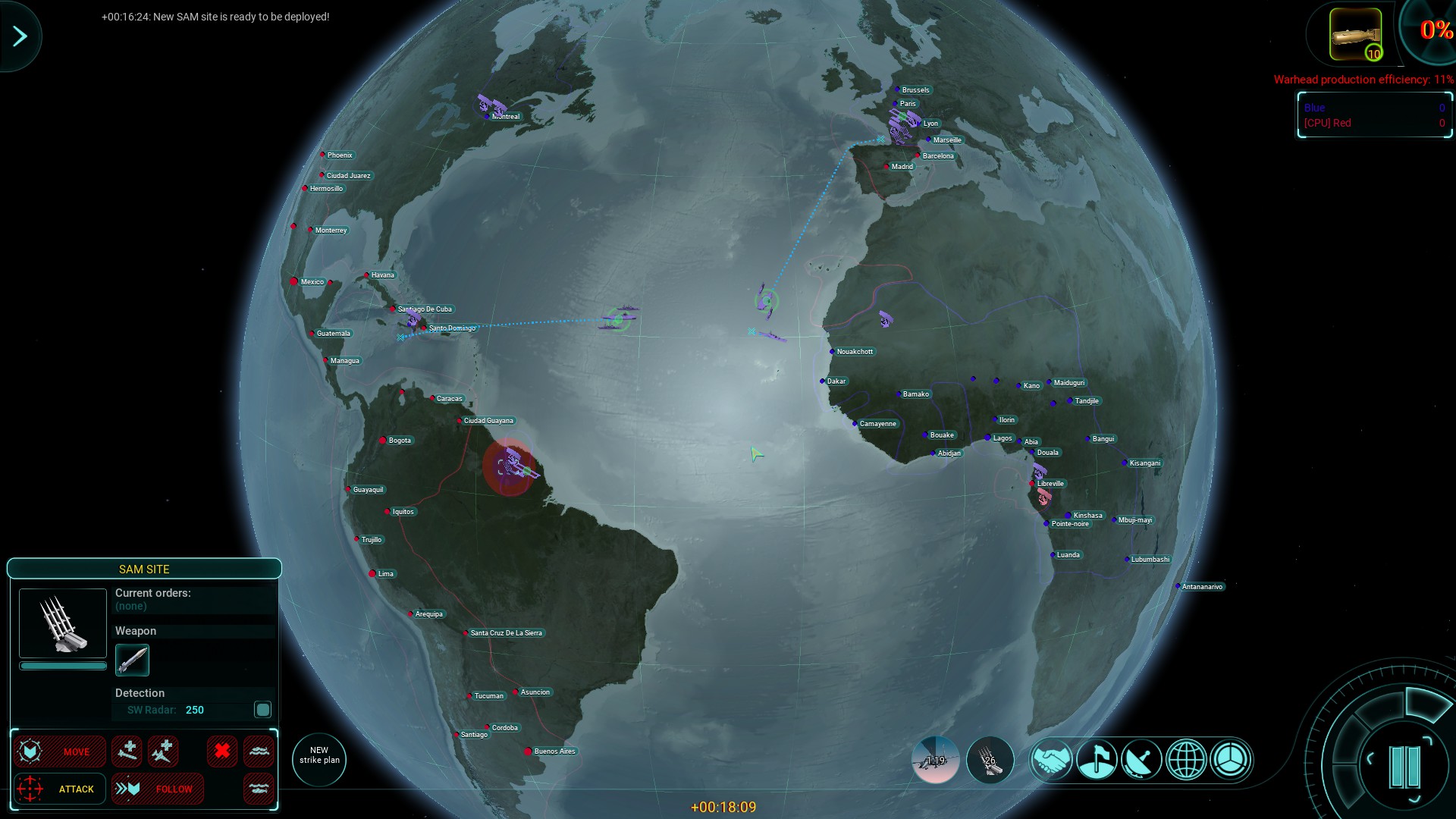
Closing Thoughts
This is one of those times where it would be good to have two review scores, one for singleplayer and one for multiplayer. While the mechanics are the same in SP as in MP, the game ends up feeling very different. I am admittedly not very good at the multiplayer, but I still really enjoyed what I played, and this is where the games longevity is. As a multiplayer game this is a clear “Save”, it’s really fun and tense, while as a singleplayer game I would rate it as a “Save for later”. It’s not bad in singleplayer, but after a few hours it started to feel a bit repetitive. Overall though, ICBM is a good game, and a worthy successor to Defcon.










